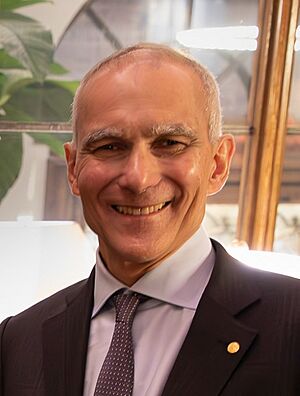Moungi Bawendi facts for kids
Quick facts for kids
Moungi Bawendi
|
|
|---|---|
| منجي الباوندي | |

Bawendi in 2023
|
|
| Born | 15 March 1961 |
| Education | Harvard University (BA, MA) University of Chicago (PhD) |
| Known for | hot-injection synthesis of quantum dots |
| Relatives | M. Salah Baouendi (father) |
| Awards | Nobel Prize in Chemistry (2023) |
| Scientific career | |
| Fields | Chemistry Quantum chemistry |
| Institutions | Massachusetts Institute of Technology |
| Thesis | From the Biggest to the Smallest Polyatomic Molecules: Statistical Mechanics and Quantum Mechanics in Action (1988) |
| Doctoral advisor | Karl Freed Takeshi Oka |
| Doctoral students | Christopher B. Murray Cherie Kagan |
Moungi Bawendi (born March 15, 1961) is a famous chemist with American, Tunisian, and French backgrounds. He works as a professor at the Massachusetts Institute of Technology (MIT). Bawendi is well-known for his important work in making high-quality quantum dots. For this amazing work, he received the Nobel Prize in Chemistry in 2023.
Contents
Early Life and Education
Moungi Bawendi was born in Paris, France. His father, M. Salah Baouendi, was a mathematician from Tunisia. Moungi lived in France and Tunisia before his family moved to the United States when he was a child. They settled in West Lafayette, Indiana, because his father worked at Purdue University. Moungi finished high school in 1978.
College and Career Start
Bawendi went to Harvard University, where he earned two degrees in 1982 and 1983. He then got his Ph.D. in chemistry from the University of Chicago in 1988. His teachers there were Karl Freed and Takeshi Oka.
During his studies, Bawendi worked on different science projects. He also spent a summer at Bell Labs. There, a scientist named Louis E. Brus introduced him to the exciting world of quantum dots. After finishing his Ph.D., Bawendi worked with Brus at Bell Labs. In 1990, Bawendi joined the Massachusetts Institute of Technology (MIT), becoming a full professor in 1996.
Amazing Quantum Dot Research
Moungi Bawendi is a leading expert in the study and creation of quantum dots. Quantum dots are super tiny semiconducting crystals. Because they are so small, they have special light and electronic features.
A big challenge for scientists was making quantum dots that were stable and all the same size. Bawendi is famous for finding ways to make high-quality quantum dots in a standard way. In 1993, he and his students, David J. Norris and Christopher B. Murray, found a new method. This "hot-injection synthesis" method allowed them to make quantum dots that were very similar in size and had great optical quality.
This discovery was a huge step forward. It meant scientists could "tune" quantum dots by changing their size. This allowed them to predict and control the properties of the dots. This breakthrough made it possible to use quantum dots in many new technologies.
Today, quantum dots are used in many things we see every day. They are in light-emitting diodes (LEDs) for bright screens and lights. They are also used in photovoltaics (solar cells) to capture sunlight. Other uses include biomedical imaging to see inside the body and various sensors.
Awards and Honors
Moungi Bawendi has received many awards for his scientific work.
- In 1994, he received the Sloan Research Fellowship.
- He won the Nobel Signature Award for Graduate Education in Chemistry in 1997.
- In 2001, he was given the Sackler Prize in Physical Chemistry of Advanced Materials.
- He received the Ernest Orlando Lawrence Award in 2006.
Bawendi was also chosen to be a member of several important science groups:
- The American Association for the Advancement of Science in 2003.
- The American Academy of Arts and Sciences in 2004.
- The National Academy of Sciences in 2007.
In 2010, he received the ACS Award in Colloid and Surface Chemistry. He also won the 2011 SEMI Award for North America for his quantum dot research.
In 2020, Bawendi was recognized as a Clarivate Citation Laureate in Chemistry. This was for his work on making tiny crystals with exact features for many uses. He shared this honor with Christopher B. Murray and Hyeon Taeghwan.
In 2023, Moungi Bawendi was awarded the Nobel Prize in Chemistry. He shared this prestigious award with Louis E. Brus and Alexey Ekimov. They won for their discovery and creation of quantum dots. He also received the Medal of Honor from the Tunis University.
Decorations
Personal Life
Moungi Bawendi is married to Rachel Zimmerman, who is a journalist.

